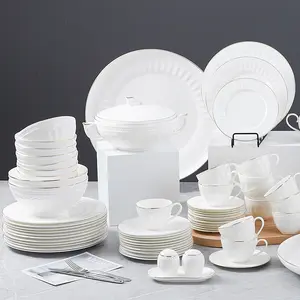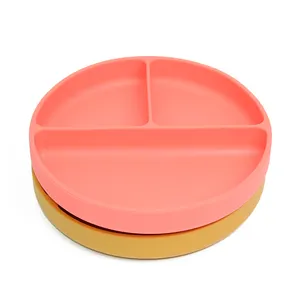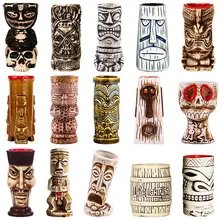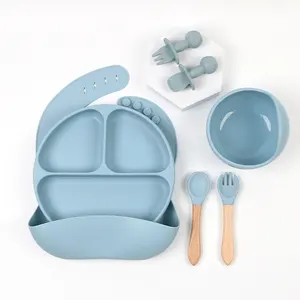A children's tableware set is a vital assortment of dining implements tailored for the use of young ones, typically featuring a size suitable for small hands, robust construction, and whimsical motifs. These collections usually comprise plates, bowls, cups, and cutlery, designed to meet the culinary requirements of toddlers and preschoolers aged between 1 and 4. The aesthetic range of children's tableware spans sleek, contemporary designs to opulent, classic styles, with an array of patterns and forms to captivate and motivate little ones at mealtime.
Types and Characteristics of Children's Tableware
The variety of children's tableware is extensive, addressing diverse needs and tastes. Some sets incorporate compartments, ideal for fussy eaters who prefer their food items discrete. Others boast interactive elements with didactic themes, aiding in the educational enrichment of children as they dine. Themed ensembles, embellished with figures from beloved children's entertainment, can make dining a more thrilling affair for young enthusiasts. Each variant fulfills a distinct role, whether to render mealtimes more enjoyable, instructive, or tailored to a youngster's specific dietary habits. Moreover, eco-conscious parents are drawn to sustainable options like bamboo. The assortment also includes microwave-safe sets and travel-friendly versions with secure lids and compartments for dining on the move.
Structure and Operation of Children's Tableware
The architecture of children's tableware is ingeniously crafted with the needs of its young users in mind. A standard set might feature a plate with elevated rims to minimize spillage, bowls with suction bases for table stability, and cups with handles for tiny grips. Cutlery is typically ergonomically shaped for comfort in small palms, with soft edges for safety. The functionality of these dining implements is intuitive, empowering children to master self-feeding with tools proportioned for their success. Some sets also incorporate non-slip attributes and weighted foundations to avert mishaps, and lids vary from snap-on to screw-top to maintain freshness and contain spills.
Materials and Their Properties
The materials selected for children's tableware prioritize safety and endurance. Silicone is favored for its unbreakable nature and pliability. Ceramic presents a more traditional aesthetic and is quite resilient, though it is heavier and more prone to breakage. Bone china offers an exquisite choice that melds sturdiness with a refined look. These substances are commonly devoid of hazardous chemicals, ensuring their safety for daily use by children. Silicone stands out for its thermal resilience, accommodating a wide range of culinary preparations. Ceramic and bone china, while more delicate, provide a non-porous surface that is simple to sanitize and resistant to bacterial growth.
Business Usages and Applications
In commercial settings, children's tableware proves indispensable in venues like pediatric hospitals, childcare facilities, and eateries that welcome families. They offer a secure and attractive means for children to partake in meals, enhancing client contentment and fostering repeat patronage. In the retail sphere, these items are promoted as perfect presents, boosting sales during festive periods and special events. Their robustness and safety attributes render them a sensible investment for businesses catering to young families. In educational contexts, children's tableware doubles as an instrument for imparting dining etiquette and promoting nutritious eating habits, adding pedagogic value to the mealtime experience.
Functions of Children's Tableware
The primary purpose of children's tableware is to simplify the eating process for youngsters. They are crafted to endure the vigorous use typical of children learning to eat on their own. Certain dishes come with lids to keep meals warm or to store uneaten portions. Others are designed with compartments to teach portion control and encourage a well-rounded diet. The role of each item in a children's tableware set is to make dining as delightful and tidy as possible for both the child and the parents. Moreover, the design often includes features that support the development of a child's independence, such as easy-to-hold utensils and segmented plates that promote sampling a variety of foods.
Features of Children's Tableware
The distinctive attributes of children's tableware encompass non-toxic construction, microwave and dishwasher compatibility, and designs that merge practicality with visual appeal. Many collections are also designed to nest for compact storage. The unique selling propositions of these items often center on their creative designs, like plates with integrated games or bowls that signal safe eating temperatures by changing color. Some sets are specifically crafted to ease the transition from bottle to solids, featuring tender spoons that are gentle on gums and simple for infants to handle.
Benefits of Children's Tableware
The advantages of children's tableware are manifold. They aid in honing fine motor skills as children practice maneuvering cutlery. The captivating designs can make dining less daunting and more pleasurable, potentially leading to improved dietary habits. For parents, the ease of cleaning these items, coupled with their longevity, translates to less time devoted to tidying up and savings on replacements. The psychological gains are also noteworthy, as children experience a sense of ownership and confidence when using utensils that are perfectly sized for them and reflect their personal interests.
How do children's tableware sets enhance the dining experience for children?
Children's tableware sets enhance the dining experience by rendering meals more interactive and enjoyable. The vibrant hues and patterns captivate the attention of young diners, while the child-appropriate sizes and forms facilitate self-feeding and learning. The segmented sections in some tableware also promote portion control and introduce the concept of a balanced diet to youngsters.
What should be considered when selecting children's tableware?
When choosing children's tableware, it is important to consider the child's age and developmental stage to ensure the set is suitable. The material is also a critical factor; for example, silicone is ideal for younger children due to its robustness and safety. Additionally, the design should entice the child, featuring their preferred colors or characters, to make mealtime more appealing. Lastly, the ease of cleaning should be taken into account, as children's tableware should be dishwasher safe to maintain hygiene.
How to maintain and care for children's tableware?
To maintain children's tableware, regular cleaning is crucial. Most are designed to be dishwasher safe, offering convenient sanitation. For silicone and plastic items, steer clear of abrasive cleaners to avoid damage. Ceramic and bone china require careful handling to prevent chips. After cleansing, it's essential to thoroughly dry the tableware to avert mold and mildew, particularly in silicone items with crevices.








































 浙公网安备 33010002000092号
浙公网安备 33010002000092号 浙B2-20120091-4
浙B2-20120091-4